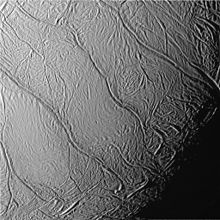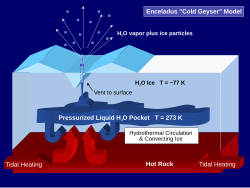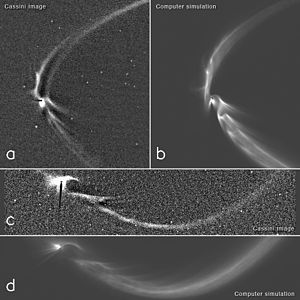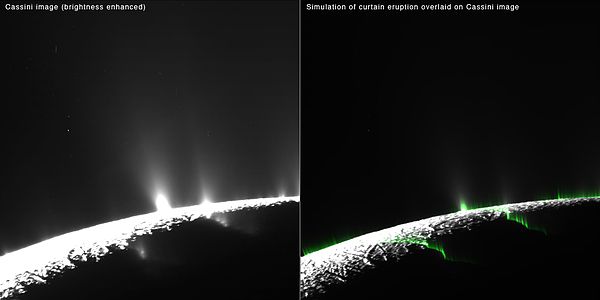
The tiger stripes of Enceladus consist of four sub-parallel, linear depressions in the south polar region of the Saturnian moon. First observed on May 20, 2005, by the Cassini spacecraft's Imaging Science Sub-system (ISS) camera (though seen obliquely during an early flyby), the features are most notable in lower resolution images by their brightness contrast from the surrounding terrain. Higher resolution observations were obtained by Cassini's various instruments during a close flyby of Enceladus on July 14, 2005. These observations revealed the tiger stripes to be low ridges with a central fracture. Observations from the Composite Infrared Spectrometer (CIRS) instrument showed the tiger stripes to have elevated surface temperatures, indicative of present-day cryovolcanism on Enceladus centered on the tiger stripes.
Names
The name tiger stripes is an unofficial term given to these four features based on their distinctive albedo. Enceladean sulci (subparallel furrows and ridges), like Samarkand Sulci and Harran Sulci, have been named after cities or countries referred to in The Arabian Nights. Accordingly, in November 2006, the tiger stripes were assigned the official names Alexandria Sulcus, Cairo Sulcus, Baghdad Sulcus and Damascus Sulcus (Camphor Sulcus is a smaller feature that branches off Alexandria Sulcus). Baghdad and Damascus sulci are the most active, while Alexandria Sulcus is the least active.
Appearance and geology

Images from the ISS camera onboard Cassini revealed the 4 tiger stripes to be a series of sub-parallel, linear depressions flanked on each side by low ridges. On average, each tiger stripe depression is 130 kilometers long, 2 kilometers wide, and 500 meters deep. The flanking ridges are, on average, 100 meters tall and 2–4 kilometers wide. Given their appearance and their geologic setting within a heavily tectonically deformed region, the tiger stripes are likely to be tectonic fractures. However, their correlation with internal heat and a large, water vapor plume suggests that tiger stripes might be the result of fissures in Enceladus' lithosphere. The stripes are spaced approximately 35 kilometers apart. The ends of each tiger stripe differ in appearance between the anti-Saturnian and sub-Saturnian hemisphere. On the anti-Saturnian hemisphere, the stripes terminate in hook-shaped bends, while the sub-Saturnian tips bifurcate dendritically.
Virtually no impact craters have been found on or near the tiger stripes, suggesting a very young surface age. Surface age estimates based on crater counting yielded an age of 4–100 million years assuming a lunar-like cratering flux and 0.5-1 million years assuming a constant cratering flux.
Composition
Another aspect that distinguishes the tiger stripes from the rest of the surface of Enceladus are their unusual composition. Nearly the entire surface of Enceladus is covered in a blanket of fine-grained water ice. The ridges that surround the tiger stripes are often covered in coarse-grained, crystalline water ice. This material appears dark in the Cassini camera's IR3 filter (central wavelength 930 nanometers), giving the tiger stripes a dark appearance in clear-filter images and a blue-green appearance in false-color, near-ultraviolet, green, near-infrared images. The Visual and Infrared Mapping Spectrometer (VIMS) instrument also detected trapped carbon dioxide ice and simple organics within the tiger stripes. Simple organic material has not been detected anywhere else on the surface of Enceladus.
The detection of crystalline water ice along the tiger stripes also provides an age constraint. Crystalline water ice gradually loses its crystal structure after being cooled and subjected to the Saturnian magnetospheric environment. Such a transformation into finer-grained, amorphous water ice is thought to take a few decades to a thousand years.
Cryovolcanism
See also: Cryovolcano

Observations by Cassini during the July 14, 2005 flyby revealed a cryovolcanically active region on Enceladus centered on the tiger stripe region. The CIRS instrument revealed the entire tiger stripe region (south of 70° South latitude) to be warmer than expected if the region were heated solely from sunlight. Higher resolution observations revealed that the hottest material near Enceladus' south pole is located within the tiger stripe fractures. Color temperatures between 113 and 157 kelvins have been obtained from the CIRS data, significantly warmer than the expected 68 kelvins for this region of Enceladus.
Data from the ISS, Ion and Neutral Mass Spectrometer (INMS), Cosmic Dust Analyser (CDA) and CIRS instruments show that a plume of water vapor and ice, methane, carbon dioxide, and nitrogen emanates from a series of jets located within the tiger stripes. The amount of material within the plume suggests that the plume is generated from a near-surface body of liquid water. Over 100 geysers have been identified on Enceladus.
Alternatively, Kieffer et al. (2006) suggest that Enceladus' geysers originate from clathrate hydrates, where carbon dioxide, methane, and nitrogen are released when exposed to the vacuum of space by the fractures.
Enceladus - Cryovolcanism-
 One possible scheme for Enceladus's cryovolcanism
One possible scheme for Enceladus's cryovolcanism
-
 Possible origins of methane found in plumes through its subsurface ocean
Possible origins of methane found in plumes through its subsurface ocean
-
 Chemical composition of the plumes of Enceladus
Chemical composition of the plumes of Enceladus
Relation to E-Ring of Saturn
Plumes from the moon Enceladus, which seems similar in chemical makeup to comets, have been shown to be the source of the material in the E Ring. The E Ring is the widest and outermost ring of Saturn (except for the tenuous Phoebe ring). It is an extremely wide but diffuse disk of microscopic icy or dusty material. The E ring is distributed between the orbits of Mimas and Titan.
Numerous mathematical models show that this ring is unstable, with a lifespan between 10,000 and 1,000,000 years, therefore, particles composing it must be constantly replenished. Enceladus is orbiting inside this ring, in a place where it is narrowest but present in its highest density, raising suspicion since the 1980s that Enceladus is the main source of particles for the E ring. This hypothesis was confirmed by Cassini's first two close flybys in 2005.

 View of Enceladus's orbit from the side, showing Enceladus in relation to Saturn's E ring
View of Enceladus's orbit from the side, showing Enceladus in relation to Saturn's E ring
-
 Enceladus orbiting within Saturn's E ring
Enceladus orbiting within Saturn's E ring
-
 Enceladus geyser tendrils - comparison of images ("a";"c") with computer simulations
Enceladus geyser tendrils - comparison of images ("a";"c") with computer simulations
-
 Enceladus south polar region - locations of most active tendril-producing geysers
Enceladus south polar region - locations of most active tendril-producing geysers

(video animation)
References
- Drake, Nadia (9 December 2019). "How an Icy Moon of Saturn Got Its Stripes - Scientists have developed an explanation for one of the most striking features of Enceladus, an ocean world that has the right ingredients for life". The New York Times. Retrieved 11 December 2019.
- ^ Porco, C. C.; Helfenstein, P.; Thomas, P. C.; Ingersoll, A. P.; Wisdom, J.; West, R.; Neukum, G.; Denk, T.; Wagner, R. (10 March 2006). "Cassini Observes the Active South Pole of Enceladus". Science. 311 (5766): 1393–1401. Bibcode:2006Sci...311.1393P. doi:10.1126/science.1123013. PMID 16527964. S2CID 6976648.
- J. Perry (23 May 2005). "New Enceladus Raw Images". Retrieved 22 March 2006.
- ^ Spencer, J. R.; Pearl, J. C.; Segura, M.; Flasar, F. M.; Mamoutkine, A.; Romani, P.; Buratti, B. J.; Hendrix, A. R.; Spilker, L. J.; Lopes, R. M. C. (2006). "Cassini Encounters Enceladus: Background and the Discovery of a South Polar Hot Spot". Science. 311 (5766): 1401–1405. Bibcode:2006Sci...311.1401S. doi:10.1126/science.1121661. PMID 16527965. S2CID 44788825.
- "New Names Approved for Use on Enceladus". SaturnToday.Com. SpaceRef Interactive Inc. 2006-11-17. Retrieved 2008-09-20.
{{cite web}}: External link in|work= - ^ R. H. Brown et al., Science 311 1425 (2006).
- Cassini Finds Enceladus Tiger Stripes are Really Cubs Archived 2008-10-18 at the Wayback Machine. Retrieved March 22, 2006.
- ^ Dyches, Preston; Brown, Dwayne; et al. (July 28, 2014). "Cassini Spacecraft Reveals 101 Geysers and More on Icy Saturn Moon". NASA. Retrieved July 29, 2014.
- NASA's Cassini Images Reveal Spectacular Evidence of an Active Moon Archived 2011-10-29 at the Wayback Machine. 6 December 2005. Retrieved March 22, 2006.
- "Jet Spots in Tiger Stripes". CICLOPS web site. NASA/JPL/GSFC/SwRI/SSI. 2008-03-26. Archived from the original on 2011-07-25. Retrieved 2009-08-30.
{{cite web}}: External link in|work= - Kieffer, Susan W.; Xinli Lu; et al. (2006). "A Clathrate Reservoir Hypothesis for Enceladus' South Polar Plume". Science. 314 (5806): 1764–1766. Bibcode:2006Sci...314.1764K. doi:10.1126/science.1133519. PMID 17170301. S2CID 41743663.
- Battersby, Stephen (26 March 2008). "Saturn's moon Enceladus surprisingly comet-like". New Scientist. Retrieved 16 April 2015.
- "Icy Tendrils Reaching into Saturn Ring Traced to Their Source". NASA News. 14 April 2015. Archived from the original on 2015-04-16. Retrieved 2015-04-15.
- Hedman, M. M.; Burns, J. A.; et al. (2012). "The three-dimensional structure of Saturn's E ring". Icarus. 217 (1): 322–338. arXiv:1111.2568. Bibcode:2012Icar..217..322H. doi:10.1016/j.icarus.2011.11.006. S2CID 1432112.
- Vittorio, Salvatore A. (July 2006). "Cassini visits Enceladus: New light on a bright world". Cambridge Scientific Abstracts (CSA). CSA. Archived from the original on 2014-04-28. Retrieved 2014-04-27.
- Baum, W. A.; Kreidl, T. (July 1981). "Saturn's E ring: I. CCD observations of March 1980". Icarus. 47 (1): 84–96. Bibcode:1981Icar...47...84B. doi:10.1016/0019-1035(81)90093-2.
- Haff, P. K.; Eviatar, A.; et al. (1983). Haff, P. K.; Eviatar, A.; Siscoe, G. L. (eds.). "Ring and plasma: Enigmae of Enceladus". Icarus. 56 (3): 426–438. Bibcode:1983Icar...56..426H. doi:10.1016/0019-1035(83)90164-1.
- Pang, Kevin D.; Voge, Charles C.; et al. (1984). "The E ring of Saturn and satellite Enceladus". Journal of Geophysical Research. 89: 9459–9470. Bibcode:1984JGR....89.9459P. doi:10.1029/JB089iB11p09459.
- Blondel, Philippe; Mason, John (August 23, 2006). Solar System Update. Springer Science. pp. 241–243.
- Spahn, F.; Schmidt, J; et al. (2006). "Cassini Dust Measurements at Enceladus and Implications for the Origin of the E Ring". Science. 311 (5766): 1416–1418. Bibcode:2006Sci...311.1416S. CiteSeerX 10.1.1.466.6748. doi:10.1126/science.1121375. PMID 16527969. S2CID 33554377.
- Cain, Fraser (5 February 2008). "Enceladus is Supplying Ice to Saturn's A-Ring". NASA. Universe Today. Retrieved 2014-04-26.
External links
- Fountains of Enceladus – Moon of Saturn at Cosmic Secrets